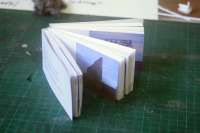Patagonia is a sound Patagonia is an overlay of maps Patagonia is invisible movement Patagonia is an imaginary territory
In Patagonia there is no monkey nor jaguar In Patagonia there is no image of God In Patagonia there is no velocity
‘Patagonia’ is perhaps one of the last places that still comprise for Western and European culture; notions of Space, Travel and Imagination. It is in fact, an imaginary territory as its boundaries are not limited by geographical co-ordinates and whose margins have been re-drawn in maps during the last 500 years, over and over again.
From the shady origin of the word ‘Patagonia’, referring to a) A literary origin: In ‘Primaleon’, a XV knights and knighthood novel, the protagonist arrives to an island where lives a monster called ‘Patagon’, b) The linguistic origin, due to the guttural sound of ‘Tehuelche’ language sounded, when spoken, as if with a twang and c) An ethnographic origin in the physical height of its inhabitants compared to other indigenous people.
This Terra Incognita Australis can be a metaphor for the colonial/post colonial paradigm.
I travelled to Patagonia in 2002 with my then husband, I wanted to create a video project that would reflect on this idea of Patagonia as an 'Imaginary territory'.
I found a wall. This wooden wall was there to protect a few houses from the wind and the inclemency of the weather, but in its pure visual image the wall was lacking any purpose. It was a boundery, dividing and protecting, a landmark amid the void of the landscape. The video was never produced, the sequences contained too much emptiness, its cosmic time appeared extremely excessive.
For UAP I recovered this footage and found a way to show it in the future. Within a flipbook I mix personal footage of the trip with the project footage, making the book a narration of the physical, aesthetic and cognitive. In the gesture of flipping the pages I hope to make evident the co-existence of different times and how the velocity and pauses in passing from one frame/still image to the other can make evident the invisible movement of Patagonia.
The result of the sequence is a real Patagonia that becomes my own narration, establishing yet another imaginary space.
Patagonia is a sound Patagonia is an overlay of maps Patagonia is invisible movement Patagonia is an imaginary territory
In Patagonia there is no monkey nor jaguar In Patagonia there is no image of God In Patagonia there is no velocity
‘Patagonia’ is perhaps one of the last places that still comprise for Western and European culture; notions of Space, Travel and Imagination. It is in fact, an imaginary territory as its boundaries are not limited by geographical co-ordinates and whose margins have been re-drawn in maps during the last 500 years, over and over again.
From the shady origin of the word ‘Patagonia’, referring to a) A literary origin: In ‘Primaleon’, a XV knights and knighthood novel, the protagonist arrives to an island where lives a monster called ‘Patagon’, b) The linguistic origin, due to the guttural sound of ‘Tehuelche’ language sounded, when spoken, as if with a twang and c) An ethnographic origin in the physical height of its inhabitants compared to other indigenous people.
This Terra Incognita Australis can be a metaphor for the colonial/post colonial paradigm.
I travelled to Patagonia in 2002 with my then husband, I wanted to create a video project that would reflect on this idea of Patagonia as an 'Imaginary territory'.
I found a wall. This wooden wall was there to protect a few houses from the wind and the inclemency of the weather, but in its pure visual image the wall was lacking any purpose. It was a boundery, dividing and protecting, a landmark amid the void of the landscape. The video was never produced, the sequences contained too much emptiness, its cosmic time appeared extremely excessive.
For UAP I recovered this footage and found a way to show it in the future. Within a flipbook I mix personal footage of the trip with the project footage, making the book a narration of the physical, aesthetic and cognitive. In the gesture of flipping the pages I hope to make evident the co-existence of different times and how the velocity and pauses in passing from one frame/still image to the other can make evident the invisible movement of Patagonia.
The result of the sequence is a real Patagonia that becomes my own narration, establishing yet another imaginary space.
